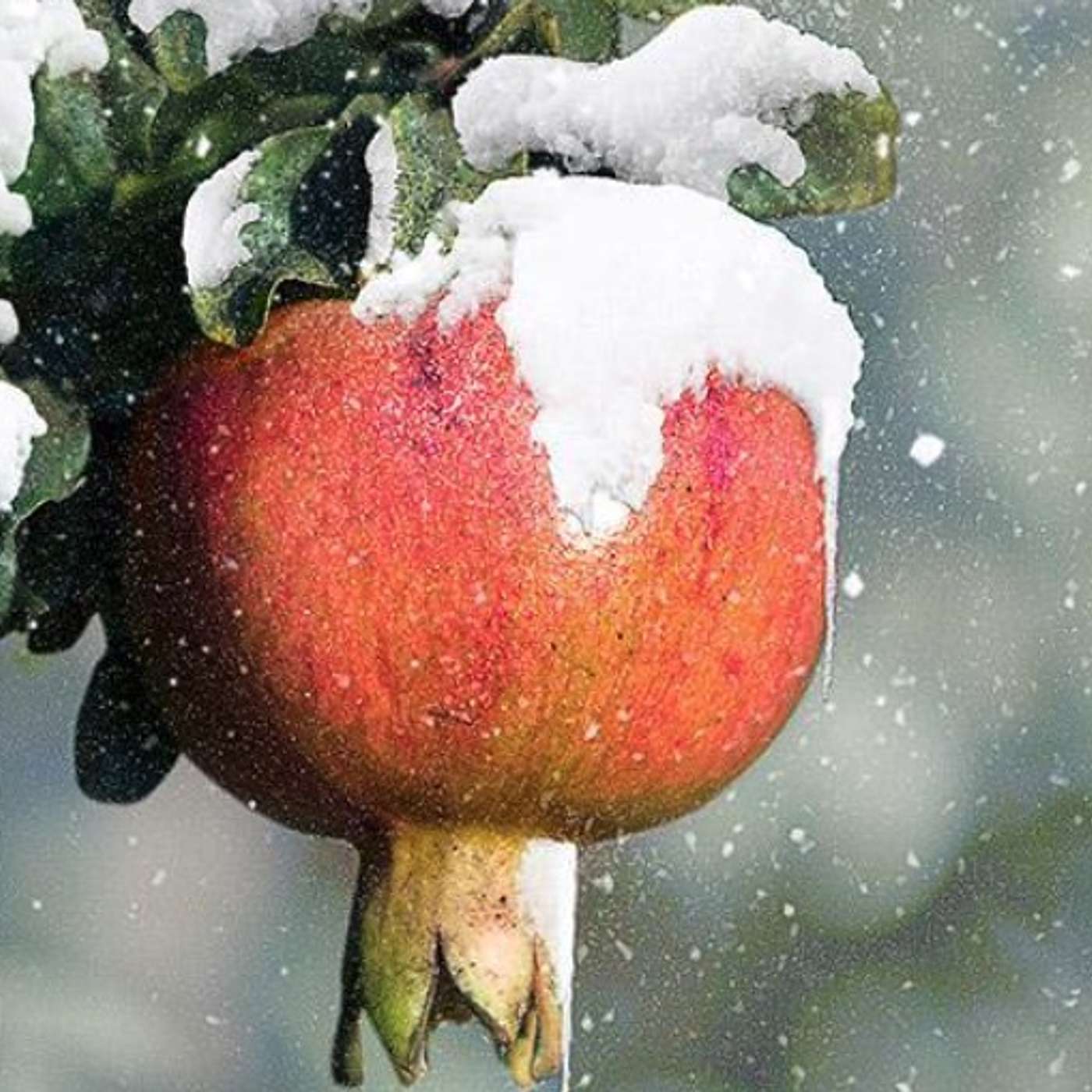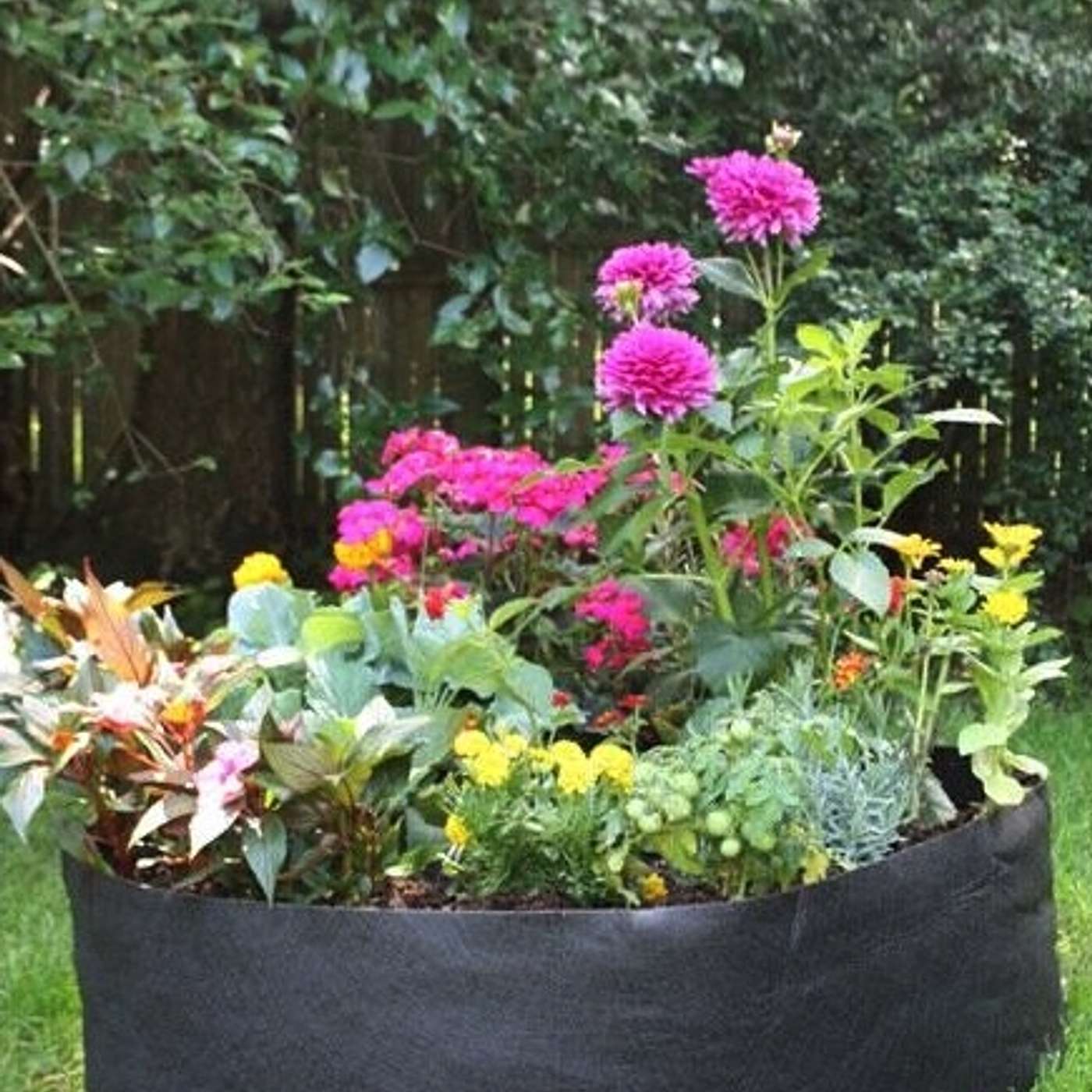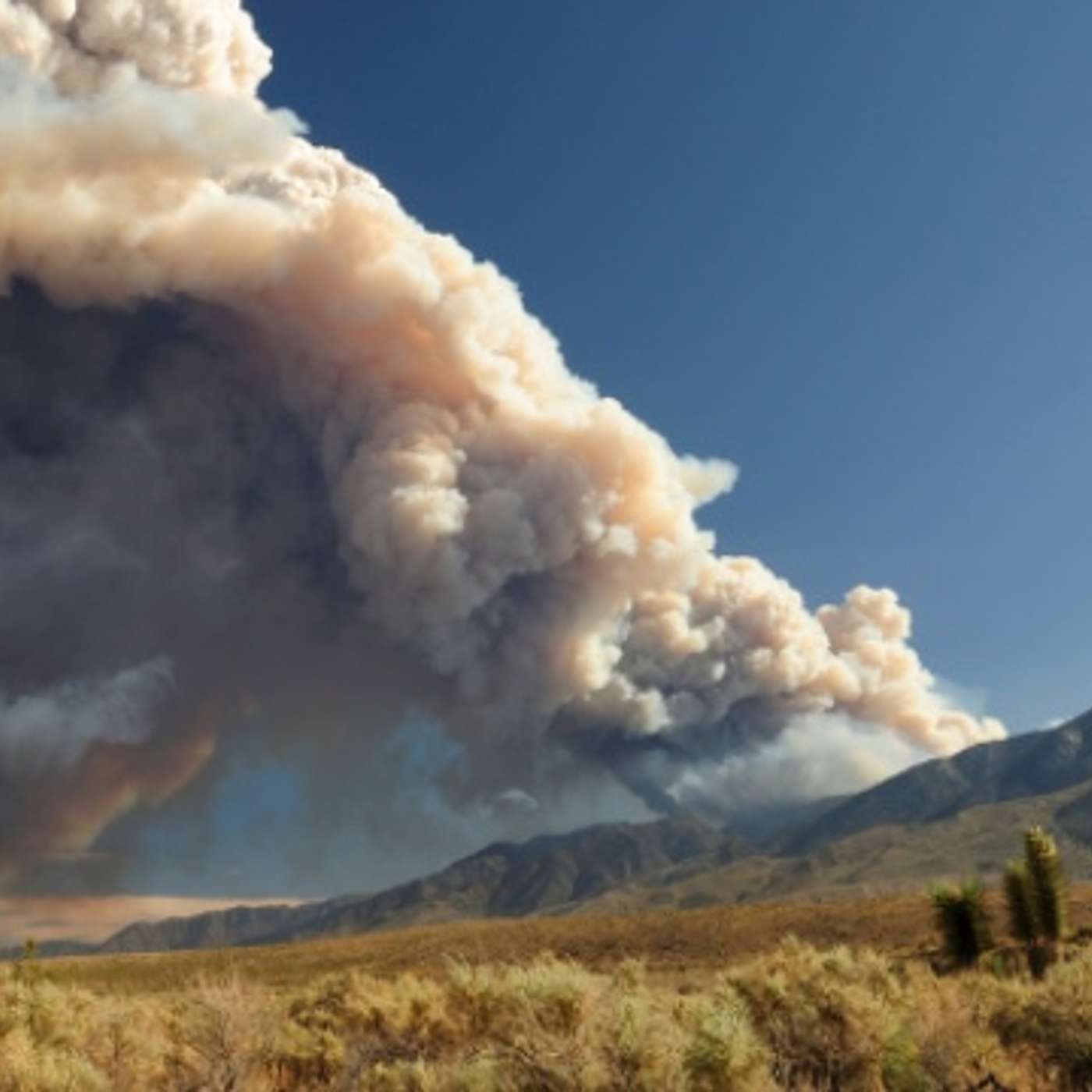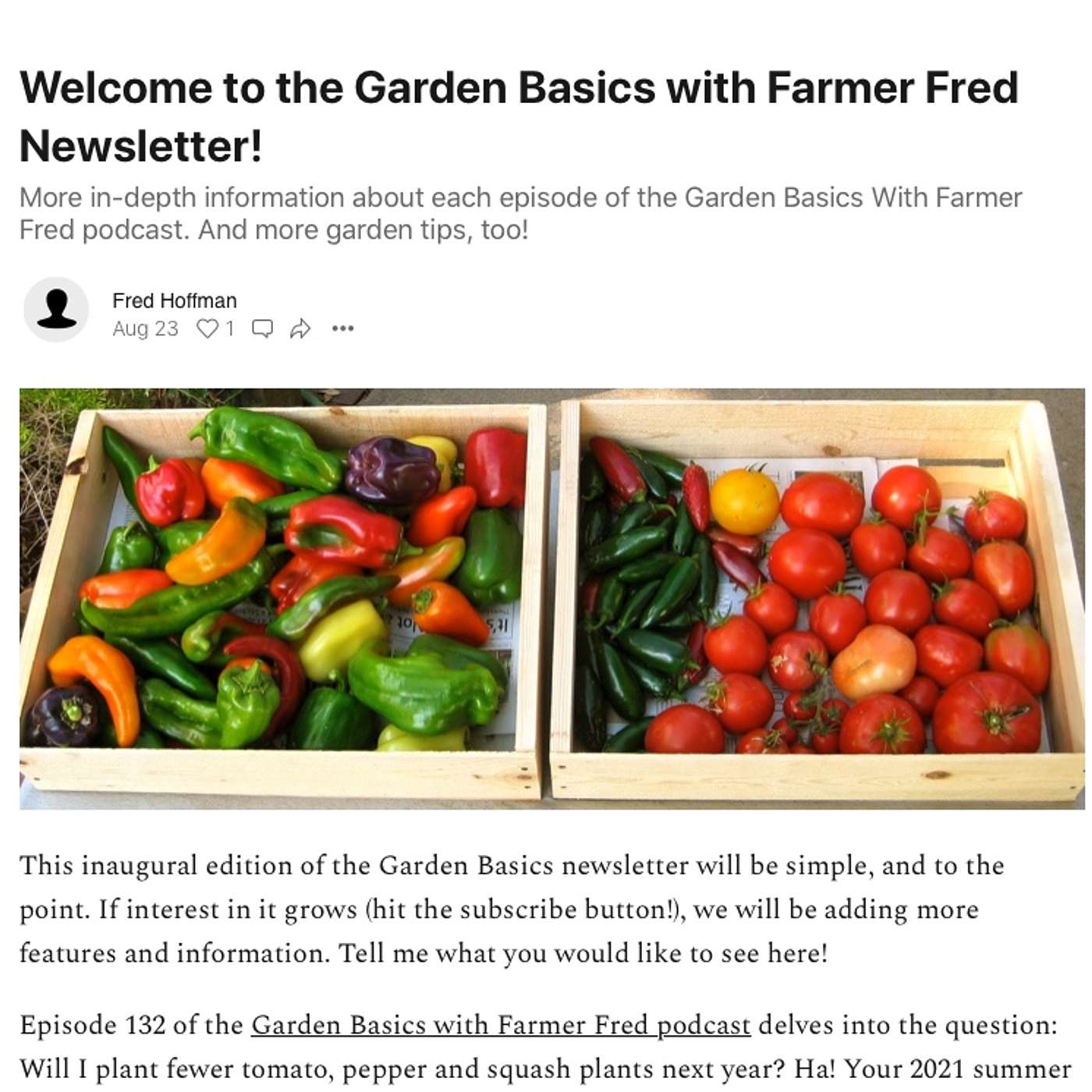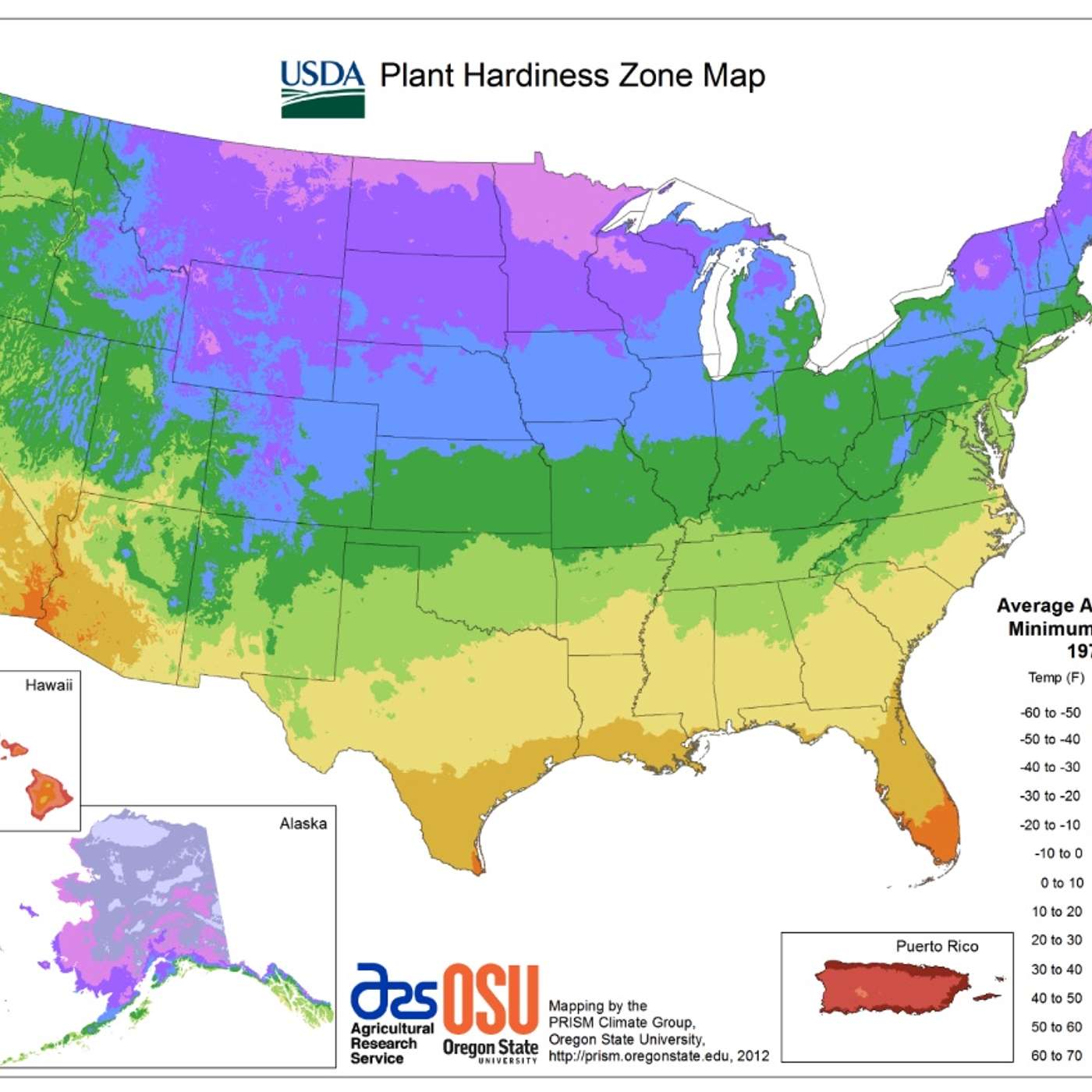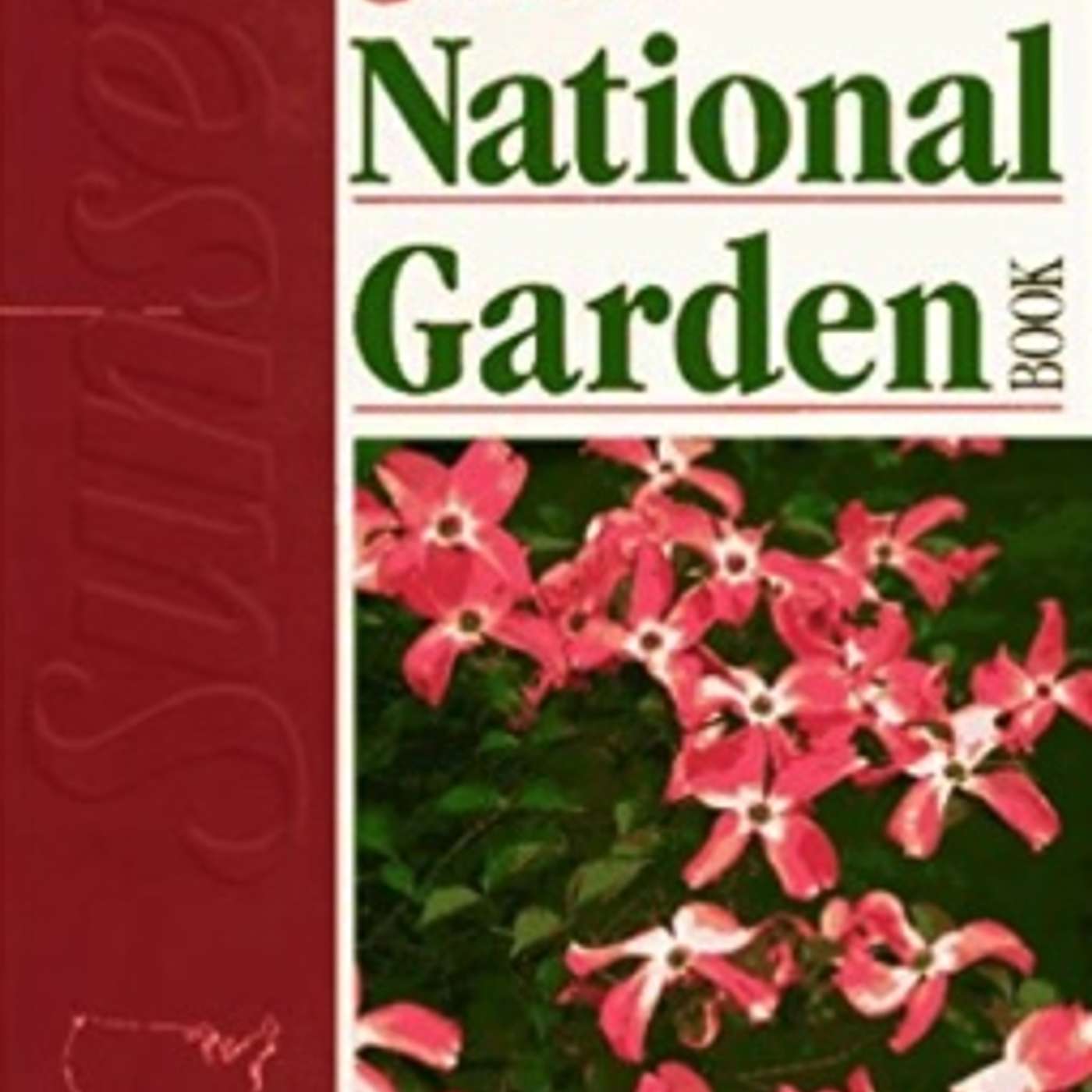Garden Basics with Farmer Fred
134 Smoke vs Your Garden. Know Your USDA Zones. Plant Protection Preparation.
Many gardeners in the western United States are breathing in wildfire smoke. So are your plants. What does smoke and falling ash do to the health of a plant? And what can you do about it? And, oddly enough, there are some benefits to that pollution.
For Eastern and Midwestern gardeners, now’s the time to plan for protecting your young, fruit producing trees and shrubs this fall and winter. We'll tell you why.
Do you know your USDA Plant Hardiness zone? We talk about that, and a better resource for figuring out your plants’ needs based on where you live.
It’s on episode 134 of the Garden Basics with Farmer Fred podcast, brought to you today by Smart Pots. And we will do it all in under 30 minutes. Let’s go!
Pictured:
The USDA Plant Hardiness Zone Map
Links:
Smart Pots
Books by Lance Walheim on Roses, Citrus, Lawns, Landscaping
USDA Plant Hardiness Zone Maps
Sunset Garden Climate Zone Maps
Sunset National Garden Book
Southern Living Garden Book
Sunset Western Garden Book
Sunset Midwestern Landscaping Book
UC Botanical Garden - The Effect of Smoke, Ash on Plants
Journal of Geophysical Research: Biogeosciences - Wildfire-Smoke Aerosols Lead to Increased Light Use Efficiency
More episodes and info available at Garden Basics with Farmer Fred
Garden Basics comes out every Tuesday and Friday. More info including live links, product information, transcripts, and chapters available at the home site for Garden Basics with Farmer Fred. Please subscribe, and, if you are listening on Apple, please leave a comment or rating. That helps us decide which garden topics you would like to see addressed.
Got a garden question? There are several ways to get in touch:
• leave an audio question without making a phone call via Speakpipe, at https://www.speakpipe.com/gardenbasics
• Call or text us the question: 916-292-8964.
• E-mail: fred@farmerfred.com
• Leave a question at the Facebook, Twitter or Instagram locations below.
Be sure to tell us where you are when you leave a question, because all gardening is local.
And thank you for listening.
All About Farmer Fred:
Farmer Fred website: http://farmerfred.com
Daily Garden tips and snark on Twitter
The Farmer Fred Rant! Blog
Facebook: "Get Growing with Farmer Fred"
Instagram: farmerfredhoffman
Farmer Fred Garden Videos on YouTube
Sign up for the new Garden Basics newsletter, on
Thank you for listening, subscribing and commenting on the Garden Basics with Farmer Fred podcast and the Beyond the Garden Basics Newsletter.
Many gardeners in the western United States are breathing in wildfire smoke. So are your plants. What does smoke and falling ash do to the health of a plant? And what can you do about it? And, oddly enough, there are some benefits to that pollution.
For Eastern and Midwestern gardeners, now’s the time to plan for protecting your young, fruit producing trees and shrubs this fall and winter. We'll tell you why.
Do you know your USDA Plant Hardiness zone? We talk about that, and a better resource for figuring out your plants’ needs based on where you live.
It’s on episode 134 of the Garden Basics with Farmer Fred podcast, brought to you today by Smart Pots. And we will do it all in under 30 minutes. Let’s go!
Pictured:
The USDA Plant Hardiness Zone Map
Links:
Smart Pots
Books by Lance Walheim on Roses, Citrus, Lawns, Landscaping
USDA Plant Hardiness Zone Maps
Sunset Garden Climate Zone Maps
Sunset National Garden Book
Southern Living Garden Book
Sunset Western Garden Book
Sunset Midwestern Landscaping Book
UC Botanical Garden - The Effect of Smoke, Ash on Plants
Journal of Geophysical Research: Biogeosciences - Wildfire-Smoke Aerosols Lead to Increased Light Use Efficiency
More episodes and info available at Garden Basics with Farmer Fred
Garden Basics comes out every Tuesday and Friday. More info including live links, product information, transcripts, and chapters available at the home site for Garden Basics with Farmer Fred. Please subscribe, and, if you are listening on Apple, please leave a comment or rating. That helps us decide which garden topics you would like to see addressed.
Got a garden question? There are several ways to get in touch:
• leave an audio question without making a phone call via Speakpipe, at https://www.speakpipe.com/gardenbasics
• Call or text us the question: 916-292-8964.
• E-mail: fred@farmerfred.com
• Leave a question at the Facebook, Twitter or Instagram locations below.
Be sure to tell us where you are when you leave a question, because all gardening is local.
And thank you for listening.
All About Farmer Fred:
Farmer Fred website: http://farmerfred.com
Daily Garden tips and snark on Twitter
The Farmer Fred Rant! Blog
Facebook: "Get Growing with Farmer Fred"
Instagram: farmerfredhoffman
Farmer Fred Garden Videos on YouTube
Sign up for the new Garden Basics newsletter, on
Thank you for listening, subscribing and commenting on the Garden Basics with Farmer Fred podcast and the Beyond the Garden Basics Newsletter.
Garden Basics 134 TRANSCRIPT Smoke vs Garden. USDA Zones. Winter Plant Protection
29:06
SPEAKERS
Farmer (66%), Debbie (17%), Lance (15%), Barry (2%)
Farmer Fred
0:00
Garden Basics with Farmer Fred is brought to you by Smart Pots, the original lightweight, long lasting fabric plant container. it's made in the USA. Visit SmartPots.com slash Fred for more information and a special discount, that's SmartPots.com/Fred.
Farmer Fred
0:20
Welcome to the Garden Basics with Farmer Fred podcast. If you're just a beginning gardener or you want good gardening information, you've come to the right spot.
Farmer Fred
0:32
Many gardeners in western states are breathing in wildfire smoke. So are your plants. What do smoke and falling ash do to the health of a plant? And what can you do about it? Oddly enough, there are some benefits to that pollution for your plants. We will tell you all about it. Now's the time to plan for protecting your young plants this fall and winter. Do you know your USDA Plant Hardiness Zone? We talk about that and a better resource for figuring out your plants needs based on where you live. It's all on episode 134 of the Garden Basics with Farmer Fred podcast, brought to you today by Smart Pots. And we'll do it all in under 30 minutes. Let's go
BI
Barry in Long Island
1:17
Hi, this is Barry, in Zone 7B on Long Island. I planted in the spring a young, two foot tall, cold hardy, Russian red pomegranate tree or bush. Even though it's cold hardy, I'm concerned about whether it's going to survive its first winter in New York. Should I be putting straw or some other insulating material around the base of the tree in late fall to protect it from the winter weather? Thank you very much, appreciate it.
FF
Farmer Fred
1:52
We appreciate your question. Barry, thank you so much for calling us from New York. Debbie Flower is here, our favorite retired college horticultural professor. Pomegranates. Now, there is a crop that can be planted just about anywhere.
DF
Debbie Flower
2:06
Yeah, it's been bred and selected and found in colder places and people are growing it in colder places and that's a really wonderful thing.
FF
Farmer Fred
2:15
But it even sounds like a cold hardy variety, with the name 'Russian' in it.
DF
Debbie Flower
2:19
Yes, Russian Red. The scientific name is Punica granatum. And I'll say this as best I can, the cultivar is 'Salavatski'. And I found that it is a registered trademark. That means that somebody has decided to call it Russian Red because 'Salavatski' is a little difficult to say. And they've registered that name, 'Russian Red', for use in their marketing. And no one else can sell it under that name without paying them some gratuities.
FF
Farmer Fred
2:48
Here in California, we don't have to worry much about freezing pomegranates.
DF
Debbie Flower
2:51
We do not, although we could grow this one here. It is ithardy in USDA zones six through nine, and it can take cold down to single digits. So that should do just fine. I lived on Long Island as a young child and went back all through my adult life. The temperatures rarely get below zero there, so it should be just fine. But Barry is right to be concerned about the first winter. The first hard season of any newly planted plant, perennial that is, (annuals will die) but perennials need to live through that winter and come out the other side. And to do so, they need to have a nice healthy growing season previous to that, and he planted it in spring. I'm aware they've had a lot of rain on Long Island. This spring certainly has gotten water. Whether it's gotten enough sun, probably if it's in a full sun location. So I would assume it has done a good job of getting established during this spring and summer growing season. Going into fall, plants are often mulched with a straw or some other loose hay. Straw is the better choice because it lacks the seeds. But something loose - mulch, pine needles, evergreen boughs at the minimum - or straw, for a couple of reasons in a cold climate. The first one is to prevent the drying out of the stems. Pomegranates are deciduous, so going into winter the stems will be bare. Cold air is very dry; cold air cannot hold a lot of moisture. Winds of cold air come whipping through, then it can dry out those stems. Stems can die from drying out. So often you see this with roses: there will be a loose, straw-type mulch mounded up around the plant, and that is to keep at least the base of the plant from drying out. The other reason to mulch a perennial plant in a cold place in winter: is to prevent heaving of the soil. Heaving happens when the soil is bare. And it has moisture in it because the plant is there or because of natural conditions such as rain, snow, whatever. And then it freezes. And when water freezes, it gets bigger. And when it gets bigger and becomes ice, it gets bigger, that ground has to go somewhere, too. It wants to get out of the way of the water and so it heaves, then the sun comes out, and it's on that bare soil and it warms up, at least the surface of the bare soil, and the water melts and maybe more water gets in and then it gets cold again and it freezes again. And this freezing and thawing cycle in a cold place in winter can cause the soil to actually move around and push the plant right out of the ground. So, you're going to mulch. We cannot prevent the soil from freezing. But we can insulate it once it is frozen and prevent that sun from hitting it directly. And so that direct sun is what melts the ice and causes the the water to penetrate further into the soil and then allows it to refreeze when the sun goes away and cause the heaving. So you're mulching for that. You wait until the soil has frozen and then you put a nice thick layer of mulch on top. So I would probably wait until the soil has frozen, that might be November ish. And then put on a nice a mounding layer which is not regularly recommended for mulching over the base of the pomegranate so that it does not dry out and it does not heave.
FF
Farmer Fred
6:03
How big a mound?
DF
Debbie Flower
6:04
When I've seen them in very cold places, they'll actually dig a plant out and knock it down and cover it. I wouldn't do that in zone seven. I wouldn't do that on Long Island. It's very well drained soil. Typically Long Island is a glacial moraine, which is when the glaciers were on earth and they pushed soil down south from the north. It piled up, it has lots of rocks, it's very well drained soil, so it it's going to drain pretty well. So I wouldn't worry about that water building up unless he's in a low spot or a modified spot. I would think a foot to 18 inches up around the plant. I don't know how big the plant is. It's only in its first season, although pomegranates I've lived with grow fairly tall, fairly quickly. But it needs to be well drained mulch, it needs to be straw or pine needles. My mother, after Christmas, would cut the branches off and go out and lay them over her perennials to prevent the heaving from happening. That's just to provide enough shade. That when the sun comes out on a particularly clear day, it doesn't melt the water and allow it to then refreeze and cause the heaving.
FF
Farmer Fred
7:07
That's a long way to go to say, "add mulch", but I understand you're getting paid by the word, so that's fine.
DF
Debbie Flower
7:13
Yeah, the same thing for every word.
FF
Farmer Fred
7:17
Debbie Flower, good answer. I like that and, Barry, good luck with your pomegranate. I think you will be successful.
DF
Debbie Flower
7:23
Yes, I think you will, too.
FF
Farmer Fred
7:29
You've heard me talk about Smart Pots, the award winning fabric planter here on the Garden Basics podcast. They're durable and reusable. I've been using mine for five years now. And once again, they're being pressed into service in my yard. Yeah, I have this problem. I grow too many tomatoes for the amount of allotted sunny space I have for them. So those extra tomato plants go into the Smart Pots. I place them in scattered areas around the yard where I know they'll get enough sun, which is a premium in my yard. And even five years later, I can pick up those Smart Pots, plant and all, and move them around without fear of the Smart Pot tearing or ripping. Smart Pots are made of breathable fabric, which creates a healthy root structure for plants. And, Smart Pots come in a wide variety of sizes and colors. Visit smartpots.com/Fred for more information about the complete line of Smart Pots, the lightweight fabric containers. And don't forget that "slash Fred" part. Because on that page are details of discounts when you buy Smart Pots on Amazon. Okay, now I understand maybe you want to see the Smart Pots before you buy them. That's not a problem. Smart Pots are available at independent garden centers and select Ace and True Value stores nationwide. To find a store near you, visit smartpots.com slash Fred.
FF
Farmer Fred
8:53
Well, we've had something on the show today for people who live in the East and in the Midwest, who have to deal with freezing winters. And now, something very pertinent to those of us living in the western United States, especially those of us who, everyday, get on the computer and check the wildfire maps. More and more of us throughout the West are having to deal with smoke. And here in the Central Valley of California, it's become an annual event: another unwanted season of falling ash and wildfire smoke. It seems to last throughout the end of summer and the beginning of fall. And yes, we gardeners do suffer from that smoke inhalation. But you know something? Your flowers and vegetables suffer, as well, on smoky days. Surprisingly, there's some benefit to your plants from all that smoke. But first, let's talk about the bad news. Out at the UC Berkeley Botanical Garden, the garden director there, Dr. Lew Feldman, has pointed out in a recent article that the combination of the toxic chemicals in the smoke is suffocating your plants. He says that chemically, more than 100 different compounds have been identified in smoke, including toxic levels of nitrous oxide, sulfur dioxide and ozone. He wrote about that in the Botanical Gardens monthly newsletter. He goes on to say that short term exposure to smoke, as little as 20 minutes, has been reported to reduce photosynthesis by as much as 50%. Feldman points out that the effect is usually accompanied by a lessening in plant growth. And that includes a reduction in fruit production and slower ripening. And, as any California winemaker can tell you, that prolonged exposure of fruits and vegetables to smoke can affect the taste. When falling ash accompanies that smoke, Feldman says that stresses the plant even more. He says when ash lodges in the pores of the plant leaves, not only is the intake of carbon dioxide retarded, but the pores can no longer function efficiently in preventing water loss from the plant. But even Feldman has a silver lining to that cloud of smoke. Ash, he says, is organic matter composed of many of the essential nutrients that plants require, including calcium, magnesium, and potassium. So if the ash accumulation is not so great as to bury the plant, the ash could be thought of as acting like fertilizer. And, there's another, if contradictory, benefit to smoky skies for your plants. This according to the Journal of Geophysical Research: Biogeosciences. Researchers in the January 2020 report indicate that wildfire smoke could increase plant productivity. How's that? Well, they studied the ecological effect of wildfire smoke here in the Central Valley of California during the summer of 2018, which was a very smoky summer, indeed. They found that the increase in production was due to the smoke scattering incoming sunlight. And that allowed the sun's energy to reach further into dense plant canopies, that increased the efficiency by which these plant canopies were photosynthesizing, leading to productivity increases. However, those researchers noted, there are some trade-offs when dealing with total light and other pollutants. And it's those other trade offs that should concern gardeners. So if you're diligent about washing off smoke and ash particles from all surfaces of the leaves on a regular basis during wildfire events, your plants will be able to respond normally, reducing possible water stress, and maybe even put on a new spurt of growth.
FF
Farmer Fred
12:29
Because there are so many demands on your time these days, I like to keep the Garden Basics podcast to under 30 minutes. Still, there is a lot more to tackle on all the garden subjects we bring up on the podcast. So, for that, and a lot more, we’re starting up The Garden Basics with Farmer Fred newsletter, on Substack. As the newsletter grows, so will the subject matter. So, yes, it will be a good supplement for the Garden Basics podcast, but there will be a lot more garden related material and probably pictures of my dogs and cats, as well. It’s the Garden Basics with Farmer Fred Newsletter on Substack. And best of all, it’s free! There’s a link in today’s show notes. Or, just go to substack.com, and do a search for Garden Basics with Farmer Fred. That’s substack.com. The Garden Basics with Farmer Fred newsletter. Did I tell you it’s free? It’s free.
FF
Farmer Fred
13:28
So what USDA zone do you live in, as far as growing plants? Zone 9? Zone 5? Are you confused about USDA hardiness zones? Welcome to the club. Let's have a little chat about USDA Plant Hardiness zones. They were created to help home gardeners and nursery owners make informed decisions about which plants will perform well in certain areas. Now this USDA hardiness zone map has undergone many versions throughout the years. Hardiness zones are based on regional low temperatures, but more exactly it's the average annual extreme minimum temperature. Then, each zone is further divided into a subzone, either A or B. For instance, here in USDA zone nine, that extreme minimum temperature is pegged at about 19 to 30 degrees. So, 9A - 19 to 25 degrees, 9B - a little bit less cold on extreme days, 25 to 30 degrees. Most plant tags, though, and references to USDA Plant Hardiness zones, stick to the whole numbers. They don't usually delve into the letters. Basically, there's about a 10 degree Fahrenheit difference from one cold zone to the next as far as those extreme cold temperatures. Probably the most common place to make mention of USDA zones are on the plant tags at your local nursery. That's a good reason to know the USDA zone you live in, especially if you live in an area that borders on two zones. Now, to figure out your USDA zone, you might have to do some squinting at small, color-coded map., Or you can visit the USDA Plant Hardiness homepage online at planthardiness.ars.usda.gov. You don't have to write that down. It's in the show notes. It'll also be in the Garden Basics newsletter that'll come out with this episode. And it'll have a nice big picture of the USDA zones across the country, as well. Now here's a rough idea of the USDA zones across the US. Remember, they reflect the average annual extreme minimum temperature only, which really isn't much data to successfully garden by. But still, it's the most widely used reference in the nursery business. Alaska and Hawaii comprise the extreme ends of that low temperature reference guide, with huge Alaska including zones one through eight. That includes temperatures that go from 16 below zero (that would be zone one) to 10 above zero (that would be zone eight). Hawaii? That's on the other end of the temperature spectrum, a state that includes zone 11, where temperatures are not anticipated to fall below 39 degrees, down to zone nine, which is primarily in the interior of the Big Island. Here in the continental United States, zone 10 can be found in southern Florida as well as parts of southern california and little pieces of Arizona. Zone nine encompasses much of the interior of California, extending from Southern California, South Texas, through northern Florida. Zone eight, where extreme lows on average are about 10 degrees, include some of the middle elevations of California, as well as much of southern Arizona and New Mexico. It travels through the Sunbelt of Texas, Louisiana, Southern Arkansas, Mississippi, Alabama, Georgia and up the coast to South Carolina, as well as much of coastal North Carolina. Zone seven, where lows can reach one degree above zero, includes much of the Intermountain West as well as North Texas, Oklahoma, Northern Arkansas, Tennessee, Kentucky, parts of northern Mississippi, Alabama and Georgia, along with Virginia, Maryland, Delaware, Rhode Island, southern New Jersey, even parts of southern New York and Pennsylvania. Most of the plants we talk about on Garden Basics are suitable for USDA zones seven through nine, and possibly six through 10. And you know, that's one of the beauties of the USDA zone maps. If you have the right microclimate, you might be able to stretch those zones up or down by one, throughout the western United States. Most of the area is six through nine until you get east of the Rockies, then the colder zones of five, four and three rule in the upper Midwest and the Northeast. But again, there are exceptions. One of the best reasons for using the USDA guide is to help you pick out plants. A perennial that's classified as being for zones eight through 10 on that plant tag, may not survive the winter in zone six. If you shop at a good local nursery, chances are that local nursery is only going to bring in plants that will survive in your area. As we know, all gardening is local. Most Californians? We garden in USDA zone nine, were winter lows average 20 to 30 degrees but there's a big difference in the plant palette between zones 9A which is 20 to 25 degree average winter lows, and 9B, which is a bit warmer, with 25 to 30 degree extreme lows. Again, go to the USDA Plant Hardiness homepage online, planthardiness.ars.usda.gov. While the average low temperature in the winter is a big factor in determining which plants will grow in your zone, the average high summer temperatures must also be considered. Many plants can't take the heat in hot climates. This high end of a plant's temperature tolerance is actually taken into consideration when plants are assigned a USDA zone range. So play it safe. Take the ever fluctuating climate into consideration when selecting trees, shrubs and perennials. All areas throughout the United States experience unusual highs and lows from time to time. Determine your hardiness zone, then choose plants that are rated hardy for at least one zone higher and one zone lower, to help ensure that the plant will survive an unexpected extreme. And consider, too, you might just live in a microclimate. Living in the warmer climates in the West and South and along the coast can make finding your gardening zone a little more complicated, though. These areas are riddled with microclimates that are influenced by elevation, humidity, or the lack of humidity, wind patterns, and a lot more. And that brings us to a superior, but harder to find reference for climate and plant adaptability: It's called the Sunset Garden Climate Zone Map, from the people that brought you the Sunset Western garden book and other regional garden books. Gardeners in the Western United States are very familiar with the Sunset Garden Book, which divides the West into 24 different zones. Sunset recognized that a plant's performance is governed by the total climate, the length of the growing season, timing and the amount of rainfall, winter lows, summer highs, humidity, persistent wind patterns, and more. Sunset's climate zone maps takes all these factors into account. And at one time, Sunset produced a National Garden Book, whose climate zone maps were broken down into 45. Count them, 45 different zones, definitely a superior system to the USDA Plant Hardiness Zone maps. But what happened to that? Well, for that portion of the story, we turned to a longtime editor of Sunset Garden books, author Lance Walheim.
FF
Farmer Fred
20:51
We're talking with Lance Walheim, longtime editor with the Sunset Western garden book series and Sunset magazine. And, at one time back in 1997, they produced the Sunset National Garden book. And Lance, you were there at the time. You were one of the managing editors on that publication. And I got to believe when those orders came down from above, or producing a national garden book, there must have been panic in the editorial room.
LW
Lance Walheim
21:21
Yeah, I think there probably was. You know, we always got requests for to expand the Western Garden book into the East. Readers were always calling in, people that had moved back east and couldn't get a comparable book to the Western garden book or people who came out from the east and saw this tattered old book, sitting on their friends table, and wanted to know what it was. And then said, 'Why can't we get this?'. So for a long time, we had requests to do just that. But the Lanes (the family that owned Sunset at the time) really wanted to stay western. And that was their focus, and they didn't have any intentions really doing it. And then in the late 80s, I think, Sunset magazine was bought out by Time-Warner, which of course is a national company, and things change. They wanted to do a National Book, they saw the opportunities. So they contacted I believe, Joe Williamson, and he was really one who spearheaded this, along with Kathy Brenzel and Dick Dunmeyer. And I was freelancing for him at that time, working on the Western Garden book and some other projects they had. So yeah, I remember going into Joe Williamson's office. He said, 'You got to come in and see what we're doing here.' And he had started to break the country into more zones, had taken the USDA zones and said, 'Look, we're going to research this and we know we can do a better job.' There were all sorts of problems with the USDA zone maps, not only when compared to the west, in the east, but also to the north to the south. So they thought that by doing the research, he thought we could come up with a better map. And that's basically what we did. There was a lot of information out there that we could use plus our new partner with Time Warner was Southern Living, and they were also working on a book and had developed some maps for the southern United States. So that's really how it started.
FF
Farmer Fred
23:14
While at that time, Sunset did have a few regional books. I recall visiting a nursery up in Truckee, which is high up in the Sierra, very cold. They have one garden month, July. And on the rack in this Nursery in Truckee was Sunset's NorthEastern garden book, which was intended for the New England states.
LW
Lance Walheim
23:36
That's exactly right. That was their long term goal, really, at Time Warner. To have these regional books. And they were done along about the same time, all those books were done. The National Book was done first so we could get those zones established. And then they were broken up into regional. So, there was the Southern Living garden book, there was the Western garden book. And there was a Northeastern garden book; there was a Midwestern landscape book, that was a little bit different. It didn't use the zones that we had. So you're right. But they all happened about the same time.
FF
Farmer Fred
24:14
Now the edition I have came out in 1997. I believe that was the first edition.
LW
Lance Walheim
24:19
Correct.
FF
Farmer Fred
24:20
Were there any more additions after that?
LW
Lance Walheim
24:22
I don't think there were. I certainly don't have a copy. I primarily worked with the encyclopedia portion of it. Like you say, that was a lot of plants. I think it just came out that one time and I'm not sure why. There were a lot of changes going on at Sunset and as well as at Time Warner. Now the Southern Living Garden book has been revised several times. I think it's in its third printing, and it's it's a very good book, too. But even with those zones that they established, we made a lot of changes in those.
FF
Farmer Fred
24:52
As you mentioned, there was, of course, a lot of corporate changes back around that time, as well. The bigger fish were gobbling the smaller fish, things change, ideas change, goals change.
LW
Lance Walheim
25:04
That's right. And the other thing that of course happened was that the internet became a primary source of information and very up to date information for a lot of people as well. So the book business in general is, not what it used to be, at a certain point, somewhere in the early 2000s.
FF
Farmer Fred
25:22
I got to believe there's a garage full of Sunset National Garden books in somebody's garage, because you can find them online as used books, and some are ridiculously high priced, and some are ridiculously low priced. If you shop around, you might be able to find a used copy for less than $10. And it certainly is a very worthwhile investment. I'm surprised that nobody else, no other publisher, has picked up the mantle on a National Garden book like this.
LW
Lance Walheim
25:51
Me too. I think there's a heck of a lot of opportunity there, at least maybe possibly to do something online. You know, as you have found out, there are practical issues developing a big climate map like this. How do you present it to people? So it makes sense. And so it's got to be broken up into many pages. If you've used the USDA map, as we all have, you know, that it's, there are some interactive things going on now. But it's hard to read. Yeah. So you've got to be able to space those sections out and make sense for people, so they can really see where they are and what's going on. So I would think if anything, there would be some real opportunities to do something on a national basis.
FF
Farmer Fred
26:35
I would think then, because of the advent of the Internet at the time, and the production of the National Garden Books, somewhere online they would have put all these maps, all this information, but the heck if I can find it. The only maps of the 45 Sunset garden zones. And by the way, it's a very good layout. It was done by Gary Ibsen and Dagma Lacey at tomatofest.com. And, yeah, Gary has been a excellent tomato grower in Central California for years and years, and his tomatofest dot com website features, many varieties that you might want to try. But buried on his website, I imagine it's been there for decades, is all the growing zone maps for Sunset, including a nice large expanded map of the entire country, and then broken down by region. So you can really zone in on where you live in the United States and see what zone and recommendations that Sunset has for your zone. And again, that's at tomatofest.com. Just do a search on that site of the "tomato growing zone maps", but it's more than just growing tomatoes. It's the complete Sunset Zone maps. It would be nice if the people who have the rights to this would at least produce the National Map again.
LW
Lance Walheim
27:59
Yeah, absolutely.
FF
Farmer Fred
28:01
Lance Walheim, by the way, is a noted citrus grower in Central California and author of several wonderful rose books that are probably in your garage now.
LW
Lance Walheim
28:13
Yeah, that's exactly right. They're in boxes. I got to start getting them out too.
FF
Farmer Fred
28:18
Okay! Rose books and citrus books, by the way, so if you're looking for some good citrus books, you can still find some online or used by Lance Walheim, W-A-L-H-E-I-M, Lance Walheim. Lance, thanks for the great information about the Sunset National Garden book.
LW
Lance Walheim
28:36
Glad to do it, Fred, good talking to you.
FF
Farmer Fred
28:43
Garden Basics comes out every Tuesday and Friday. It's brought to you by Smart Pots. Garden Basics is available wherever podcasts are handed out. And that includes Apple, Iheart, Stitcher, Spotify, Overcast, Google, Podcast Addict, Cast Box, and Pocket Casts. Thank you for listening, subscribing and leaving comments. We appreciate it.
